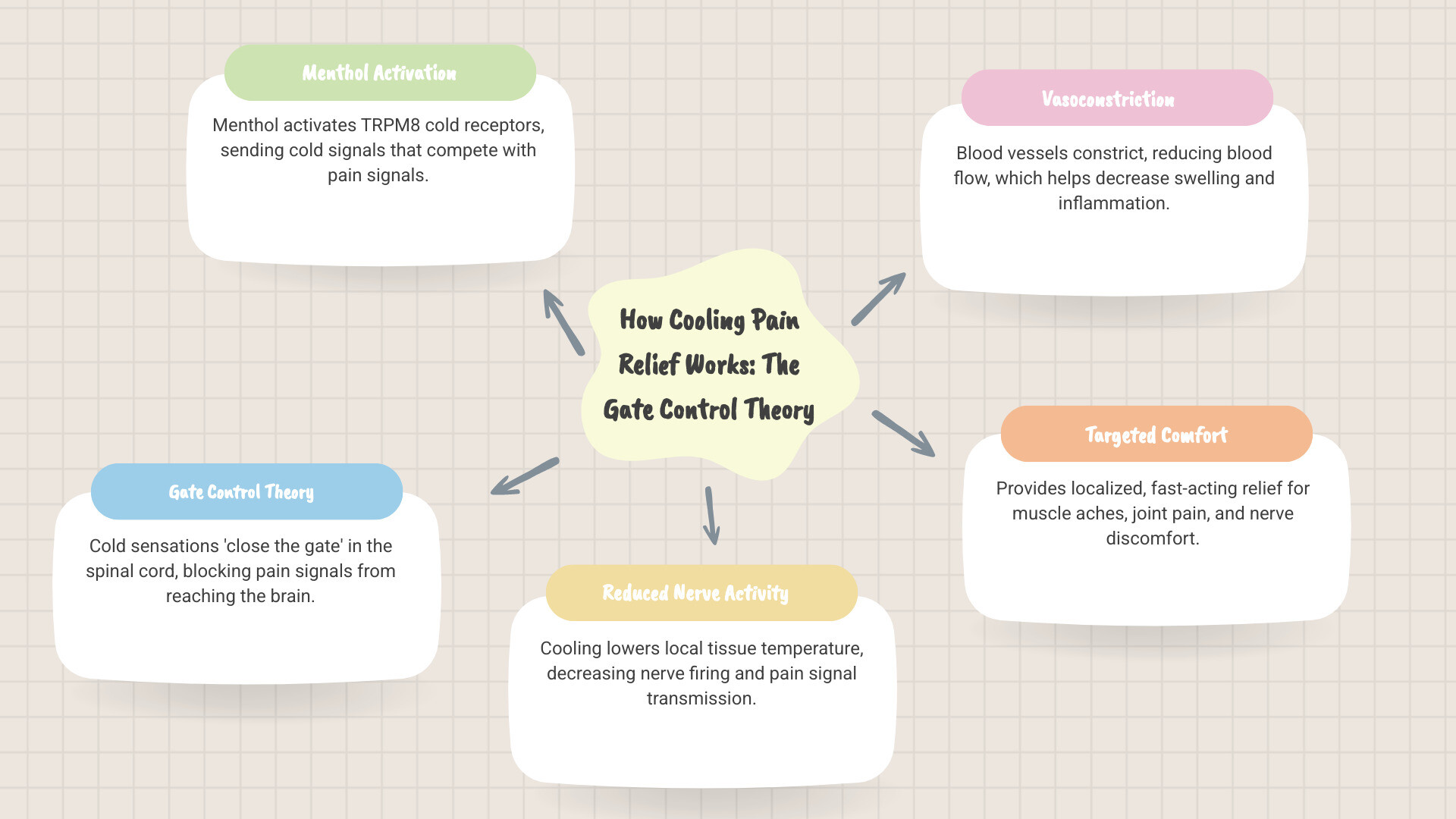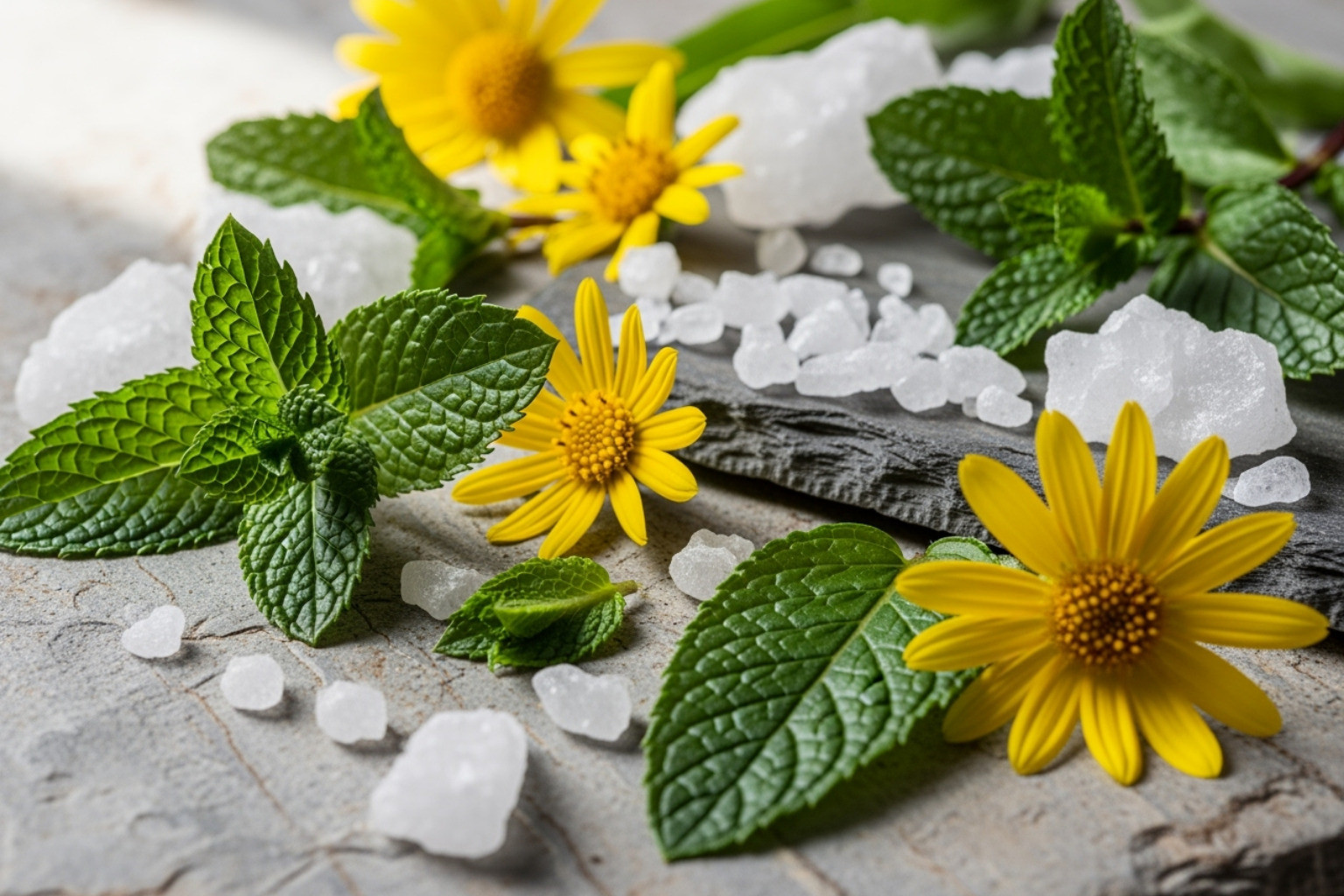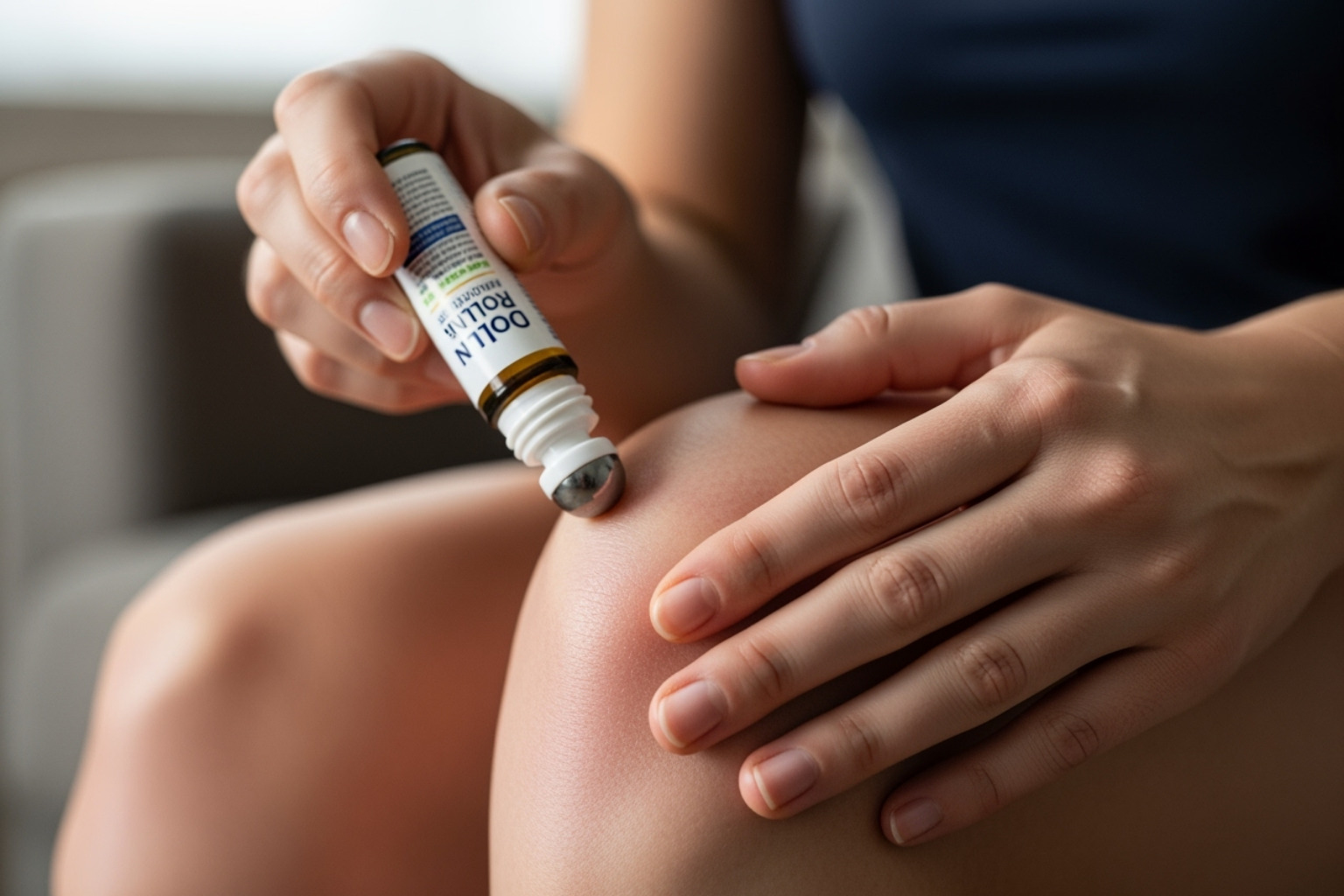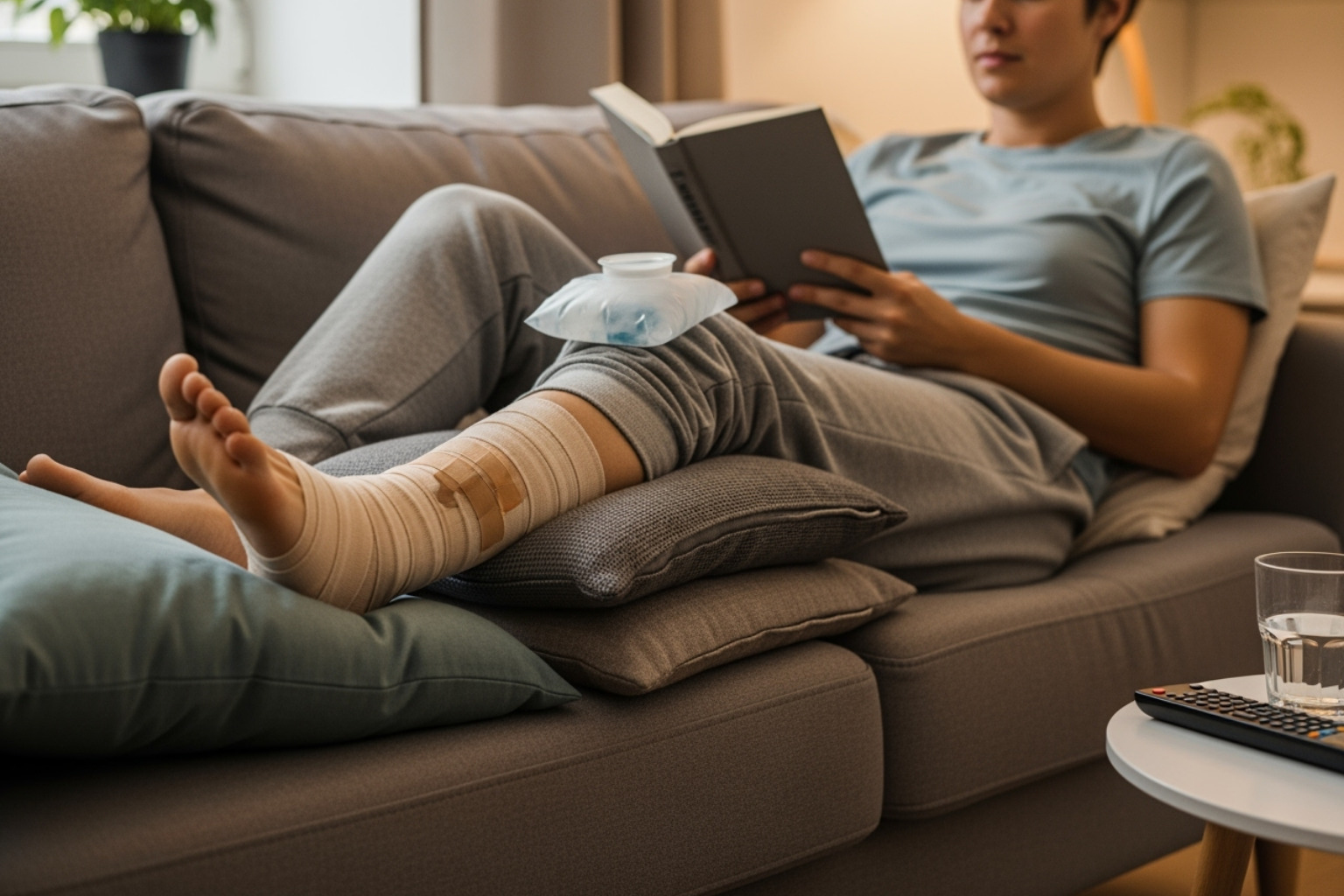Why Cooling Pain Relief Is Your Key to Targeted Comfort
Cooling pain relief provides fast-acting comfort for muscle aches, joint pain, and nerve discomfort by stimulating cold receptors that block pain signals from reaching your brain. This process, known as the gate control theory, uses the cooling power of ingredients like menthol to override pain messages. It also triggers vasoconstriction, which reduces swelling and inflammation at the source.
This makes cooling therapy ideal for acute injuries, post-workout soreness, arthritis, and nerve pain like sciatica. While an ice pack uses the same basic principle, modern cooling pain relief creams offer a significant upgrade. Specialized formulas combine menthol with natural ingredients for deeper penetration and longer-lasting comfort without the risk of cold burns associated with ice.
Research published in the journal Future Medicine confirms that menthol effectively reduces pain intensity by activating specific nerve pathways that block pain signals. It's a targeted approach that creates a barrier against pain signals while reducing inflammation.
At Neuropasil, we've seen how the right cooling formula can help people manage and conquer their pain. Our experience has helped thousands find effective cooling pain relief solutions for their unique needs.

The Science of Cool: How Cooling Pain Relief Works
The instinct to apply cold to an injury is a powerful pain-fighting mechanism, and it's the science behind modern cooling pain relief creams. When you apply a cooling cream, your body responds in several key ways.
First, vasoconstriction occurs, causing blood vessels to narrow. As explained by the Cleveland Clinic, this reduces blood flow to the area, which in turn decreases swelling and the pressure on sensitive nerve endings. Essentially, it turns down the volume on pain signals.
Second, the cold temperature reduces nerve activity, slowing down the speed at which pain messages travel along your nerves. Slower signals mean less perceived pain.
The most critical mechanism is the gate control theory. Your nervous system can only process so many signals at once. According to scientific reviews, when an ingredient like menthol activates your body's cold sensors (TRPM8 receptors), it sends fast-moving "cold" signals to the brain. These signals effectively "close the gate" on the slower-moving pain signals, blocking them from being registered.
This is why cooling pain relief is so fast and effective—it blocks pain at the source rather than just masking it. This principle is a core component of the trusted R.I.C.E. method (Rest, Ice, Compression, Elevation) used by athletes and physical therapists. As noted by experts at Johns Hopkins Medicine, cold therapy is a fundamental technique for injury care. Modern cooling creams make this therapy portable, precise, and mess-free, offering targeted relief without the risks of ice packs.
Decoding the Label: Key Ingredients in Neuropasil Cooling Cream

Understanding the ingredients in a cooling pain relief cream is key to finding a product that works. At Neuropasil, every component is chosen for a specific purpose, creating a formula where topical analgesics, counterirritants, and natural extracts work together for powerful relief.
Menthol: The Primary Cooling Agent
Menthol is the star ingredient in cooling creams. It doesn't actually lower your skin's temperature; instead, it activates TRPM8 receptors, your body's cold sensors. This sends a "cold" signal to your brain that travels faster than pain signals. According to the gate control theory, these rapid cold sensations block the slower pain messages from being processed. This mechanism, backed by numerous studies, provides immediate relief and also helps desensitize pain receptors over time, reducing overall pain sensitivity in the area.
Camphor: The Counterirritant
Camphor works as a counterirritant, creating a mild warming and cooling sensation that distracts from deeper aches. According to health experts at Mount Sinai, camphor also stimulates nerve endings, which can relieve pain and promote increased blood flow to aid in muscle repair. This makes it especially effective for the deep, nagging discomfort from overused or strained muscles.
Natural Additives: Arnica, Turmeric & Hemp Seed Oil
Neuropasil improves its formulas with natural additives that support healing and skin health.
- Arnica: A flower traditionally used for its anti-inflammatory properties. As noted by Memorial Sloan Kettering Cancer Center, it is often applied topically to soothe muscle soreness and speed up bruise healing.
- Turmeric: Contains curcumin, a compound with powerful anti-inflammatory effects. The National Center for Complementary and Integrative Health recognizes its long history in traditional medicine for treating inflammatory conditions.
- Hemp Seed Oil: An excellent moisturizer that creates a protective barrier, helping the skin absorb active ingredients more effectively.
Our formulations also include aloe vera for its soothing properties and urea to improve the penetration of other ingredients, ensuring you get the maximum benefit from every application. These extracts transform a simple cream into a comprehensive treatment that supports your body's healing process while nourishing your skin. While some products use warming agents like capsaicin, our cooling approach is a gentler alternative for inflammation and acute injuries. You can learn more about capsaicin's role in pain relief for a full spectrum of options.
The Ultimate Roundup: Finding Your Perfect Neuropasil Cooling Pain Relief Cream
Finding the right cooling pain relief cream is about matching the product to your specific pain. At Neuropasil, we offer specialized formulas because we know one size doesn't fit all. Whether you need a fast-absorbing gel for athletic recovery, a moisturizing cream for large areas, or a mess-free roll-on for on-the-go application, we have a targeted solution.

If you need more help choosing, our practical guide to finding pain cream can walk you through the options. Below is a look at how Neuropasil products address specific concerns.
Best Neuropasil Cooling Pain Relief for Nerve Pain & Neuropathy
Nerve pain, with its burning, tingling, or shooting sensations, requires a specialized approach. Our Neuropasil nerve pain formulas use menthol's ability to interrupt pain signals, combined with Aloe Vera to soothe sensitive skin. We also include Urea to improve the absorption of active ingredients, ensuring our fast-acting formula gets to work immediately when a flare-up occurs. For more on this topic, see our guide on Diabetic Neuropathy Explained.
Best Neuropasil Solution for Post-Workout Muscle Soreness
For athletic recovery, our cooling pain relief formulas are designed for active people. The fast absorption formula penetrates deep into tired muscles without leaving a greasy residue. The menthol-powered cooling reduces inflammation, helping muscles repair and strengthen. Our roll-on applicator is perfect for gym bags, offering mess-free, targeted relief. Plus, the sweat-resistant formula ensures it stays effective even during your next workout. Learn more about reducing muscle soreness after a workout and how Neuropasil helps athletes.
Best Neuropasil Option for Arthritis and Joint Pain
For arthritis pain and stiffness, our formulas are designed for deep penetration and long-lasting relief. The cream works its way into inflamed joints, where menthol's anti-inflammatory benefits calm irritation and provide comfort that lasts for hours. The roll-on applicator is ideal for those with painful hands, making it easy to apply to hard-to-reach areas. Many users report significant stiffness reduction, allowing them to return to daily activities. For more strategies, see our guides on Managing Arthritis Pain and The Ultimate Guide to Osteoarthritis.
Best Neuropasil Cream for Back and Sciatica Pain
Back and sciatica pain often cover a large area and require sustained relief. Our creams are designed for large areas, spreading smoothly to cover the lower back or the path of sciatic pain down the leg. Menthol's numbing effect is particularly effective for the sharp, radiating pain of sciatica. The formula provides sustained relief throughout the day, reducing the need for constant reapplication. For more specific guidance, explore our resources on Sciatica Relief and solutions for neck and shoulder pain.
Application and Safety: Getting the Most from Your Cooling Cream
To get the most from your cooling pain relief cream, proper application and safety are essential. A few simple steps can maximize the cream's effectiveness and prevent mistakes.

How to Apply for Maximum Cooling Pain Relief
- Start with clean, dry skin to improve absorption.
- Apply a thin, even layer. A small amount is sufficient; using too much can waste product or cause irritation.
- Follow application frequency guidelines, typically 3-4 times per day, to allow your skin to process the active ingredients.
- Wash your hands thoroughly with cool water after applying, unless you are treating your hands.
- Avoid contact with eyes and mucous membranes, as menthol can cause significant discomfort in these sensitive areas.
Safety First: Precautions and Potential Side Effects
While generally safe, keep these precautions in mind:
- For external use only. Never apply to broken skin, cuts, or wounds.
- Never combine with heating pads. As medical experts warn, this can lead to burns because the cooling sensation may mask the heat's intensity.
- Perform a patch test on a small area of skin before first use to check for skin irritation like redness or itching.
- Discontinue use if the cooling sensation becomes uncomfortable or you notice irritation. While rare with creams, cold burns can occur with overuse of some cooling products.
- Keep out of reach of children.
- Consult a healthcare professional if pain persists for more than 7 days, worsens, or recurs, as recommended by the FDA for over-the-counter topical analgesics. For any adverse reactions, consider reporting them via the FDA's MedWatch program.
Combining Therapies: Cooling Creams and Other Strategies
Cooling pain relief is most effective as part of a broader wellness strategy. Combine your Neuropasil cream with other proven methods:
- R.I.C.E. Protocol: Use your cooling cream as the "ice" component along with Rest, Compression, and Elevation for acute injuries.
- Physical Therapy and Stretching: Apply cream beforehand to relax tight muscles and make movement more comfortable. Find more tips in our guide on the best ways to relieve muscle aches.
- Mind-Body Approaches: Complement topical relief with practices like deep breathing or meditation to address the emotional component of pain.
Frequently Asked Questions about Cooling Pain Relief
Here are answers to some of the most common questions we receive about using cooling pain relief creams.
Can I use a cooling cream every day?
Yes, many people use cooling pain relief creams daily for chronic conditions like arthritis. However, it's important to follow product directions. Per FDA guidelines for over-the-counter topical analgesics, most products recommend application 3 to 4 times daily. If your pain persists for more than 7 days, it's best to consult your doctor to address any potential underlying issues.
What's the difference between cooling and heating creams?
Cooling and heating creams serve opposite purposes, and health institutions like the Cleveland Clinic offer guidance on when to use each.
- Cooling creams, like Neuropasil, cause vasoconstriction (narrowing of blood vessels) to reduce swelling and inflammation. They are best for acute injuries, fresh sprains, and post-workout soreness.
- Heating creams cause vasodilation (widening of blood vessels) to increase blood flow. This helps relax chronic muscle stiffness and soothe old injuries.
The general rule is: cold for new injuries and inflammation, heat for chronic stiffness and aches. Never use both at the same time on the same area.
How long does the cooling sensation last?
The duration of the cooling pain relief sensation can vary based on the formula and individual. However, studies on menthol-based topicals show the analgesic effect can last for several hours. The concentration of ingredients like menthol plays a significant role—a higher percentage often leads to a longer-lasting effect. You can reapply the cream as needed within the daily recommended limits.
Conclusion
Effective pain relief is within reach. Cooling pain relief works by using the science of the gate control theory, where ingredients like menthol send cooling signals to the brain that block out pain. Modern creams like Neuropasil improve this effect with natural, skin-nourishing ingredients, offering targeted relief that an ice pack can't match.
Neuropasil is different because we create specialized formulas for your personal pain, whether it's from neuropathy, arthritis, or post-workout muscle soreness. Our goal is to provide a reliable tool for your pain management toolkit, helping you reclaim comfort and mobility.
Cooling pain relief is about more than just a cold sensation; it's about taking charge of your comfort. By combining Neuropasil with rest, gentle movement, and other wellness practices, you can get back to living life on your terms.
Ready to feel the difference? Find natural solutions for nerve pain relief with Neuropasil and find what targeted relief can do for you.
References
The information in this article is supported by research and expertise from credible medical and scientific sources. These references validate the effectiveness and mechanisms of cooling therapy for pain management.
- Pergolizzi, J. V., et al. (2018). The role of menthol in pain management. Future Medicine. This review details how menthol activates TRPM8 receptors to produce a cooling sensation that blocks pain signals via the gate control theory. Available from: National Center for Biotechnology Information (NCBI)
- Cleveland Clinic. (2022). Cryotherapy (Cold Therapy). Explains how cold application causes vasoconstriction to reduce swelling and inflammation, and provides safety information on topical pain relievers. Available from: Cleveland Clinic and Cleveland Clinic Health Essentials
- Johns Hopkins Medicine. RICE Therapy for Injuries. Outlines the use of ice (cold therapy) as a fundamental component of treating acute injuries. Available from: Johns Hopkins Medicine
- Mount Sinai Health Library. Camphor. Describes the use of camphor as a counterirritant that stimulates nerve endings to relieve pain. Available from: Mount Sinai
- Memorial Sloan Kettering Cancer Center. Arnica. Provides information on the traditional use of arnica for inflammation, muscle soreness, and bruising. Available from: MSKCC
- National Center for Complementary and Integrative Health (NCCIH). Turmeric. Discusses the anti-inflammatory properties of curcumin, the active compound in turmeric. Available from: NCCIH
- U.S. Food & Drug Administration (FDA). Provides guidelines on the safe use of over-the-counter topical analgesics, including application frequency and when to consult a doctor, and hosts the MedWatch program for reporting adverse events. Available from: FDA MedWatch and CFR Title 21 Part 348













